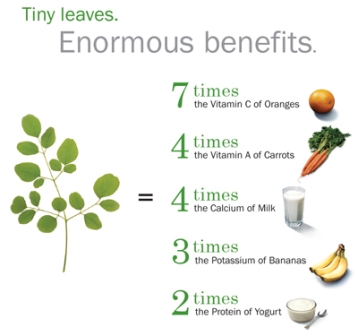Nutrition
Moringa oleifera is an autotroph which uses photosynthesis to acquires it food. It takes in water, carbon dioxide and light from the earth to produce glucose which it then stores as starch. It is a primary producer that is used as food source for animals including humans. Almost every part of the plant is edible and extremely nutritious. The part of the plant that is most widely used and valued is the immature pods because they contain all the essential amino acids along with various vitamins and nutrients. Before the pods reach maturity, they are eaten either raw or in the same way that green peas and green beans are prepared. Once the pod is mature, they are fried and possess a peanut-like taste. The oil produced by the seeds is also extremely useful. It has a sweet taste to it and never becomes rancid. The nutritional value is similar to that of olive oil. The bark is eaten as a source for coarse fiber. The flowers are rich in potassium and calcium. Unlike the immature pods, the flowers must be cooked. They are normally either mixed with other foods or fried in a batter. The leaves are one of the most versatile part of the plant. They can be eaten in salads, vegetable curries, as pickles, or used for seasoning. They can also be ground up and used as a cleaning utensil for scrubbing walls and utensils. The roots were once used as a substitute for horseradish, but it is now know that they contain alkaloids, similar to potatoes that have turned green due too much exposure to sunlight. The roots are rich in both moriginine and spirochin, both of which result can result in death after ingestion.
The nutritional value of Moringa oleifera leaves in South Africa was determined by a study in which leaves were collected and milled into a powder. The powder was then analyzed for crude protein, crude fat, dry matter, calcium, magnesium, potassium, phosphorous, zinc, iron, copper, manganese, selenium, and sodium. The amino acid composition was found using and amino acid analyzer. It was found that M. oleifera leaves contain 19 different amino acids and many nutritious compounds, the most noteworthy being crude proteins. The amount of proteins that M. oleifera contains aids in boosting the immune system and fighting diseases. It was also found to have high levels of methiononie and cystenine which are powerful antioxidants which help the body detox harmful chemicals and protect it against radiation. High levels of zinc was discovered as well. The is beneficial because zinc is essential for the synthesis of DNA, RNA, and insulin, the function of several different enzymes, and is an anti-viral, anti-bacterial, anti-fungal, and contains anti-cancer properties. Beta-carotene, the most potent precursor to vitamin A, was found to be rich in Moringa oleifera. This helps reduced anemia and the prevalence of vitamin A deficiency.
Another study was conducted to compare the nutritional value of Moringa oleifera to other indigenous food sources in Kenya. The food sources compared were:
Cereals:
finger millet (Eleusine coracana)
amaranth grain (Amaranthus cruentus)
Legumes
pigeon pea (Cajanus cajan)
field bean (Dolichos pupureum)
Oil Seeds
ground nut (Arachis hypogea)
pumpkin seeds (Cucurbita maxima)
sunflower seeds (Helianthus annuus)
Vegetables
pumpkin and pumpkin leaves (Cucurbita maxima)
butternut (Juglans cinerea)
sweet potato (Ipomoea batatas)
drumstick leaves (Moringa oleifera)
amaranth leaves (Amaranthus hybridus)
Each substance was made into an extract and
analyzed to determine the phenolic content and the antioxidant and
anti-diabetic proprieties. It was found that Moringa oleifera,
the drumstick leaves, and the amaranth leaves contain a
significantly high level of total phenolics and anti-diabetic and
antioxidant
properties compared to all the other indigenous foods analyzed. It
was also found that cooking M. oleifera did not  cause
any significant change in the phenolic content. Blanching the plant,
however, denatured the phenolic compounds and therefore adversely
affected the antioxidant and anti-diabetic properties. Because
cooking seemed to have little impact on the phenolic content, it's
the best form of preparation for this vegetable.
cause
any significant change in the phenolic content. Blanching the plant,
however, denatured the phenolic compounds and therefore adversely
affected the antioxidant and anti-diabetic properties. Because
cooking seemed to have little impact on the phenolic content, it's
the best form of preparation for this vegetable.
Moringa oleifera is especially nutritious because it has more vitamin A and C than carrots and oranges. It also has more calcium than milk, more protein than eggs, and more potassium than bananas. This is the main reason why Moringa oleifera was utilized by the ancient Greeks, Romans, and Egyptians, and still is continued to be used by those in Asia and Africa.
Find out more about the recipes that use Moringa oleifera as an ingredient here!
